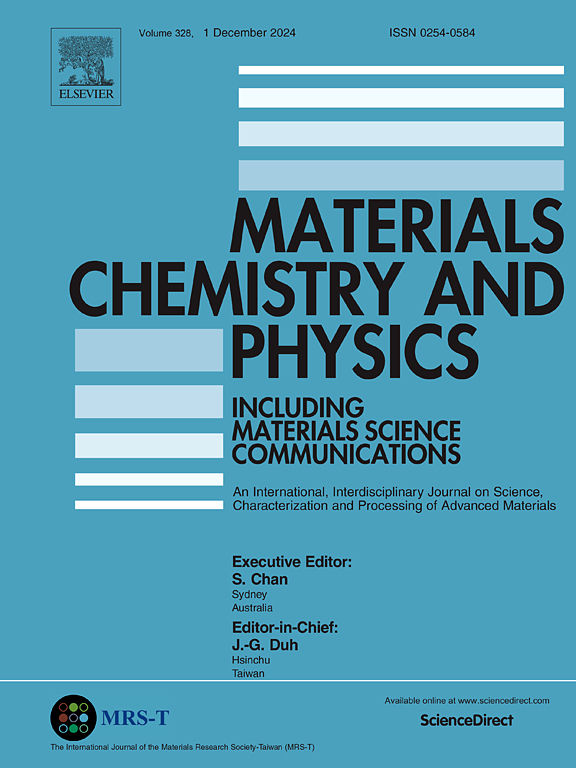Investigating the electronic properties and quantum capacitance of transition metal sulfides MS2 (M = Ti, Mo, W, V, Nb, Ta, Fe, Cu, Co): A DFT study for high-performance supercapacitors
IF 4.7
3区 材料科学
Q2 MATERIALS SCIENCE, MULTIDISCIPLINARY
引用次数: 0
Abstract
Developing high-performance supercapacitors necessitates exploring advanced electrode materials with rapid charge-discharge kinetics, high power density, and long-term electrochemical stability. This study employs DFT to unravel the electronic properties, quantum capacitance (CQ), surface charge density(σ), and thermodynamical stability of nine transition metal disulfides (MS2: M = Ti, Mo, W, V, Nb, Ta, Fe, Cu, and Co), highlighting their potential as advanced supercapacitor electrodes. Computational analyses reveal significant contrasts in performance, with layered TiS2, TaS2, and MoS2 exhibiting high CQ values of 1313.41 μF cm−2, 1111.29 μF cm−2, and 943.75 μF cm−2, respectively. Remarkably, non-layered FeS2 exhibits a competitive CQ value of 923.73 μF cm−2 while ranking as the thermodynamically most stable compound. σ analysis further revealed TiS2 (710.84 μC cm−2) and FeS2 (653.14 μC cm−2) as top performers, confirming their suitability as anode materials. In contrast, CuS2 and CoS2 have low CQ, underscoring their limited utility. The findings guide electrode material selection and encourage experimental and engineering strategies, such as heterostructure and defect modulation, to fully unlock these systems' potential. A strong correlation between DFT-predicted and experimental capacitance values validates the computational framework, confirming its reliability for guiding future electrode material design.

研究过渡金属硫化物MS2 (M = Ti, Mo, W, V, Nb, Ta, Fe, Cu, Co)的电子特性和量子电容:高性能超级电容器的DFT研究
开发高性能超级电容器需要探索具有快速充放电动力学、高功率密度和长期电化学稳定性的先进电极材料。本研究利用DFT揭示了九种过渡金属二硫化物(MS2: M = Ti, Mo, W, V, Nb, Ta, Fe, Cu和Co)的电子特性,量子电容(CQ),表面电荷密度(σ)和热力学稳定性,突出了它们作为先进超级电容器电极的潜力。计算分析表明,层状的TiS2、TaS2和MoS2的CQ值分别为1313.41 μF cm−2、1111.29 μF cm−2和943.75 μF cm−2。值得注意的是,非层状FeS2具有923.73 μF cm−2的竞争CQ值,是热力学最稳定的化合物。σ分析结果表明,TiS2 (710.84 μC cm−2)和FeS2 (653.14 μC cm−2)表现最佳,适合作为阳极材料。相比之下,CuS2和CoS2的CQ较低,强调了它们的有限效用。这些发现指导了电极材料的选择,并鼓励实验和工程策略,如异质结构和缺陷调制,以充分释放这些系统的潜力。dft预测值与实验电容值之间的强相关性验证了计算框架,证实了其指导未来电极材料设计的可靠性。
本文章由计算机程序翻译,如有差异,请以英文原文为准。
求助全文
约1分钟内获得全文
求助全文
来源期刊

Materials Chemistry and Physics
工程技术-材料科学:综合
CiteScore
8.70
自引率
4.30%
发文量
1515
审稿时长
69 days
期刊介绍:
Materials Chemistry and Physics is devoted to short communications, full-length research papers and feature articles on interrelationships among structure, properties, processing and performance of materials. The Editors welcome manuscripts on thin films, surface and interface science, materials degradation and reliability, metallurgy, semiconductors and optoelectronic materials, fine ceramics, magnetics, superconductors, specialty polymers, nano-materials and composite materials.
 求助内容:
求助内容: 应助结果提醒方式:
应助结果提醒方式:


